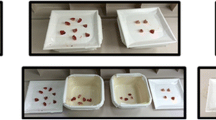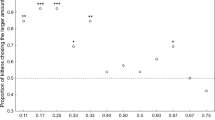Abstract
Quantity discrimination is adaptive in a variety of ecological contexts and different taxa discriminate stimuli differing in numerousness, both in the wild and in laboratory settings. Quantity discrimination between object arrays has been suggested to be more demanding than between food arrays but, to our knowledge, the same paradigm has never been used to directly compare them. We investigated to what extent capuchin monkeys’ relative numerousness judgments (RNJs) with food and token are alike. Tokens are inherently non-valuable objects that acquire an associative value upon exchange with the experimenter. Our aims were (1) to assess capuchins’ RNJs with food (Experiment 1) and with tokens (Experiment 2) by presenting all the possible pair-wise choices between one to five items, and (2) to evaluate on which of the two proposed non-verbal mechanisms underlying quantity discrimination (analogue magnitude and object file system) capuchins relied upon. In both conditions capuchins reliably selected the larger amount of items, although their performance was higher with food than with tokens. The influence of the ratio between arrays on performance indicates that capuchins relied on the same system for numerical representation, namely analogue magnitude, regardless of the type of stimuli (food or tokens) and across both the small and large number ranges.



Similar content being viewed by others
References
Addessi E, Crescimbene L, Visalberghi E (2007) Do capuchin monkeys (Cebus apella) use tokens as symbols?. Proc R Soc B 274:2709–2715
Agrillo C, Dadda M, Bisazza A (2007) Quantity discrimination in female mosquitofish. Anim Cogn 10:63–70
Anderson US, Stoinski TS, Bloomsmith MA, Marr MJ, Smith AD, Maple TL (2005) Relative numerousness judgment and summation in young and old western lowland gorillas. J Comp Psychol 119:285–295
Bateson M, Kacelnik A (1996) Rate currencies and the foraging starling: the fallacy of the averages revisited. Behav Ecol 7:341–352
Beran MJ (2001) Summation and numerousness judgments of sequentially presented sets of items by chimpanzees (Pan troglodytes). J Comp Psychol 115:181–191
Beran MJ (2004) Chimpanzees (Pan troglodytes) respond to nonvisible sets after one-by-one addition and removal of items. J Comp Psychol 118:25–36
Beran MJ (2007) Capuchin monkeys (Cebus apella) succeed in a test of quantity conservation. Anim Cogn. doi:10.1007/s10071-007-0094-3
Beran MJ, Rumbaugh DM (2001) “Constructive” enumeration by chimpanzees (Pan troglodytes) on a computerized task. Anim Cogn 4:81–89
Beran MJ, Beran MM, Harris EH, Washburn DA (2005) Ordinal judgements and summation of nonvisible sets of food items by two chimpanzees and a rhesus macaque. J Exp Psychol Anim B 31:351–362
Boysen ST, Berntson GG (1995) Responses to quantity: perceptual versus cognitive mechanisms in chimpanzees (Pan troglodytes). J Exp Psychol Anim B A21:82–86
Brosnan SF, de Waal FBM (2004) A concept of value during experimental exchange in brown capuchin monkeys, Cebus apella. Folia Primatol 75:317–330
Call J (2000) Estimating and operating on discrete quantities in orangutans (Pongo pygmaeus). J Comp Psychol 114:136–147
Chen MK, Lakshminarayanan V, Santos L (2006) How basic are behavioral biases? Evidence from capuchin-monkey trading behavior. J Polit Econ 114:517–537
Cowles J (1937) Food-tokens as incentive for learning by chimpanzees. Comp Psychol Mon 14:1–96
Davis H, Pérusse R (1988) Numerical competence in animals: definitional issues, current evidence, and new research agenda. Behav Brain Sci 11:561–615
Dehane S (1997) The number sense, Oxford University Press, New York
Feigenson L, Carey S (2003) Tracking individuals via object files: evidence from infants’ manual search. Dev Sci 6:568–584
Feigenson L, Carey S, Hauser M (2002) The representations underlying infants’ choice of more: object files versus analog magnitudes. Psychol Sci 13:150–156
Feigenson L, Dehaene S, Spelke E (2004) Core systems of number. Trends Cogn Sci 8:307–314
Flombaum J, Junge J, Hauser M (2005) Rhesus monkeys (Macaca mulatta) spontaneously compute addition operations over large numbers. Cognition 97:315–325
Gallistel CR, Gelman R (1992) Preverbal and verbal counting and computation. Cognition 44:43–74
Gallistel CR, Gelman R (2000) Non-verbal numerical cognition: from reals to integers. Trends Cogn Sci 4:59–65
Green L, Fry A, Myerson J (1994) Discounting of delayed rewards: a life-span comparison. Psychol Sci 5:33–36
Hauser M, Carey S, Hauser L (2000) Spontaneous number representation in semi-free-ranging rhesus monkeys. P Natl Acad Sci USA 267:829–833
Hauser M, Spelke E (2004) Evolution and developmental foundations of human knowledge. In: Gazzaniga M (ed). The cognitive neuroscience, 3rd edn. MIT, Cambridge
Jordan KE, Brannon EM (2006) Weber’s Law influences numerical representations in rhesus macaques (Macaca mulatta). Anim Cogn 9:159–172
Judge PG, Evans TA, Vyas DK (2005) Ordinal representation of numeric quantities by brown capuchin monkeys (Cebus apella). J Exp Psychol Anim B 31:79–94
Kelleher RT (1956) Intermittent conditioned reinforcement in chimpanzees. Science 124:679–680
Kelleher RT (1957a) A multiple schedule of conditioned reinforcement with chimpanzees. Psychol Rep 3:485–491
Kelleher RT (1957b) A comparison of conditioned and food reinforcement on a fixed-ratio schedule in chimpanzees. Psychol Newslett 8:88–93
Meck WH, Church RM (1983) A mode control model of counting and timing processes. J Exp Psychol Anim B 9:320–334
Nieder A (2005) Counting on neurons: the neurobiology of numerical competence. Nat Neurosci 6:177–190
Nieder A Miller EK (2003) Coding of cognitive magnitude: compressed scaling of numerical information in the primate prefrontal cortex. Neuron 37:149–157
Nieder A, Miller EK (2004) Analog numerical representations in rhesus monkeys: evidence for parallel processing. J Cogn Neurosci 16:889–901
Pylyshyn ZW (1989) The role of location indexes in spatial perception: a sketch of the FINST spatial-index model. Cognition 32:65–97
Rachlin H, Raineri A, Cross D (1991) Subjective probability and delay. J Exp Anal Behav 55:233–244
Ramseyer A, Pele M, Dufour V, Chauvin C, Thierry B (2006) Accepting loss: the temporal limits of reciprocity in brown capuchin monkeys. Proc R Soc B 273:179–184
Richards JB, Mitchell SH, de Wit H, Seiden LS (1997) Determination of discount functions in rats with an adjusting-amount procedure. J Exp Anal Behav 67:353–366
Rilling M (1993) Invisible counting animals: a history of contributions from comparative psychology, ethology and learning theory. In: Boysen ST, Capaldi EJ (eds) The development of numerical competence: animal and human models. Lawrence Erlbaum Associates, Hillsdale
Rumbaugh DM, Savage-Rumbaugh S, Hegel MT (1987) Summation in chimpanzees (Pan troglodytes). J Exp Psychol Anim B 13:107–115
Simon TJ (1997) Reconceptualizing the origins of number knowledge: a “non-numerical” account. Cogn Dev 12:349–372
Sousa C, Matsuzawa T (2001) The use of tokens as rewards and tools by chimpanzees (Pan troglodytes). Anim Cogn 4:213–221
Stevens JR, Wood JN, Hauser MD (2007) When quantity trumps number: discrimination experiments in cotton-top tamarins (Saguinus oedipus) and common marmosets (Callithrix jacchus). Anim Cogn. doi:10.1007/s10071-007-0081-8
Tomonaga M (2007) Relative numerosity discrimination by chimpanzees (Pan troglodytes): evidence for approximate numerical representations. Anim Cogn. doi:10.1007/s10071-007-0089-0
Trick LM, Pylyshyn ZW (1994) Why are small and large numbers enumerated differently? A limited-capacity preattentive stage in vision. Psychol Rev 101:80–102
Uller C, Carey S, Huntley-Fenner G, Klatt L (1999) What representations might underlie infant numerical knowledge? Cogn Dev 14:1–36
Uller C, Jaeger R, Guidry G, Martin C (2003) Salamanders (Plethodon cinereus) go for more: rudiments of numbers in an amphibian. Anim Cogn 6:105–112
vanMarle K, Aw J, McCrinck K, Santos LR (2006) How capuchin monkeys (Cebus apella) quantify objects and substances. J Comp Psychol 120:416–426
Xu F (2003) Numerosity discrimination in infants: evidence for two systems of representations. Cognition 89:B15–B25
Xu F, Spelke ES (2000) Large number discrimination in 6-month-old infants. Cognition 74:B1–B11
Xu F, Spelke ES, Goddard S (2005) Number sense in human infants. Dev Sci 8:88–101
Westergaard GC, Liv C, Chavanne TJ, Suomi SJ (1998) Token-mediated tool-use by a tufted capuchin monkey (Cebus apella). Anim Cogn 1:101–106
Wolfe J (1936) Effectiveness of token-rewards for chimpanzees. Comp Psychol Mon 12:1–72
Acknowledgments
We are grateful to Valentina Truppa and Francesco Natale for statistical advice, to Elena Gonzalez Torres, Alessandra Mancini, Monica Maranesi, Gloria Sabbatini and Francesca Virgili for helping with data collection, and to three anonymous referees whose suggestions improved a previous version of the manuscript. We also thank the Bioparco SPA for hosting our Primate Centre and our keepers Massimiliano Bianchi and Simone Catarinacci. Funded by VI Framework, NEST Pathfinder Initiative “What it means to be human”, Contract no. 12984, “Stages in the Evolution and Development of Sign Use”—SEDSU. This study complied with protocols approved by the Italian Health Ministry and all procedures were performed in full accordance with the European law on humane care and use of laboratory animals.
Author information
Authors and Affiliations
Corresponding author
Rights and permissions
About this article
Cite this article
Addessi, E., Crescimbene, L. & Visalberghi, E. Food and token quantity discrimination in capuchin monkeys (Cebus apella). Anim Cogn 11, 275–282 (2008). https://doi.org/10.1007/s10071-007-0111-6
Received:
Revised:
Accepted:
Published:
Issue Date:
DOI: https://doi.org/10.1007/s10071-007-0111-6




